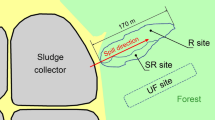Summary
The fungal floras of plant communities and mineral soils were determined at locations both close to and away from sites of human activity. Petroleum contaminated soils and discarded wood which occur near Stations were also studied, the former for bacterial as well as fungal colonization. The fungal floras of uncontaminated natural communities comprised relatively few species, Geomyces pannorum, Phoma herbarum and Thelebolus microsporus being the most common, together with Epicoccum nigrum at Mawson. P. herbarum dominated the fungal floras of mosses at Mossell Lake but E. nigrum was also common in Mawson mossbeds. G. pannorum was widespread and colonized a range of different habitats, particularly in the Vestfold Hills. T. microsporus was also widespread particularly at sites frequented by birds and seals. Phialophora fastigiata was common around the Stations, especially Davis Station, in soils including those contaminated with oil and in wood, and is thought to have been introduced with softwood packing crates. A greater range of taxa including Mortierella, Mucor, Penicillium and Cladosporium spp. was recorded from Mawson Station than from other sites, and this was attributed to the effects of human activity. Few fungi but a range of bacteria were isolated from the petroleum contaminated soils. A high percentage of these soils contained bacteria which could utilize hydrocarbons as a sole carbon source. Some of these bacteria showed a strong degradative potential, namely Flavobacterium spp., Corynebacterium spp., Bacillus spp. and an isolate from the family Enterobacteriaceae. One isolate of Corynebacterium and the Enterobacteriaceae isolate were active hydrocarbon degraders at 1°C. Hormoconis resinae, the imperfect state of Amorphotheca resinae was only isolated from oil spill soils and then only from sites of recent spills. Geomyces pannorum and Thelebolus microsporus were less common in oil contaminated soils than in uncontaminated soils.
Similar content being viewed by others
References
Allsopp D, Seal KJ (1986) Introduction to biodeterioration. Edward Arnold, London
Cameron RE (1971) Antarctic soil microbial and ecological investigations. In: Quam LO, Porter HD (eds) Research in the Antarctic. AAAS Publication, Washington DC, pp 137–189
Cruickshank RH, Pitt JI (1987) Identification of species in Penicillium subgenus Penicillium by enzyme electrophoresis. Mycologia 79:614–620
Domsch KH, Gams W, Anderson TH (1980) Compendium of soil fungi. Academic Press, London New York
Dowding D, Widden D (1974) Some relationships between fungi and their environment in tundra regions. In: Holding AJ, Heal OW, MacLean SE Jr, Flanagan PW (eds) Soil organisms and decomposition in tundra. Tundra Biome Steering Committee, Stockholm, pp 123–150
Fletcher LD, Kerry EJ, Weste GM (1985) Microfungi of Mac. Robertson and Enderby Lands, Antarctica. Polar Biol 4:81–88
Holding AJ (1981) The microflora of tundra. In: Bliss LC, Heal OW, Moore JJ (eds) Tundra ecosystems: a comparative analysis, Cambridge University Press, Cambridge, pp 561–585
Hurst JL, Pugh GJF, Walton DWH (1983) Fungal succession and substrate utilization on leaves of three South Georgia phanerogams. Br Antarct Surv Bull 56:89–100
Ivarson KC (1974) Comparative survival and decomposing ability of four fungi isolated from leaf litter at low temperatures. Can J Soil Sci 54:245–260
Lewis Smith RI (1988) Recording bryophyte microclimate in remote and severe environments. In: Glime JM (ed) Methods in bryology. Proc Bryol Workshop, Mainz (FRG), pp 275–284
Line MA (1988) Microbial flora of some soils of Mawson base and the Vestfold Hills, Antarctica. Polar Biol 8:421–427
Loveday J (1974) Methods for analysis of irrigated soils. Technical Communication 54, Commonwealth Bureau of Soils
Park PB (1975) Biodeterioration in aircraft fuel systems. In: Gilbert RJ, Lovelock DW (eds) Microbial aspects of the deterioration of materials. Academic Press, London New York, pp 105–126
Parberry DG (1972) The soil as a natural source of Cladosporium resinae. In: Walters AH, Hueck-van der Plas EH (eds) Biodeterioration of materials, vol 2. Applied Science Publishers, London
Pickard J (1986) (ed) Antarctic Oasis. Terrestrial environments and history of the Vestfold Hills. Academic Press, London New York
Pugh GJF, Allsopp D (1982) Microfungi on Signy Island, South Orkney Islands. Br Antarct Surv Bull 57:55–67
Rautella GS, Cowling EB (1966) Simple cultural test for relative celluloytic activity of fungi. Appl Microbiol 14:892–898
Rounsevell DA (1981) A population of Nanorchestes antarcticus (Acari; Prostigmata) at the Vestfold Hills, Antarctica. ANARE Sci Rep Ser B (1) Zool Publ 131
Warcup JH (1950) The soil plate method for isolation of fungi from soil. Nature 166:117–118
Author information
Authors and Affiliations
Rights and permissions
About this article
Cite this article
Kerry, E. Microorganisms colonizing plants and soil subjected to different degrees of human activity, including petroleum contamination, in the Vestfold hills and MacRobertson Land, Antarctica. Polar Biol 10, 423–430 (1990). https://doi.org/10.1007/BF00233690
Received:
Accepted:
Issue Date:
DOI: https://doi.org/10.1007/BF00233690




